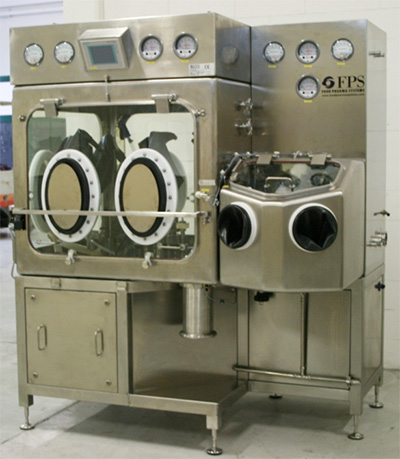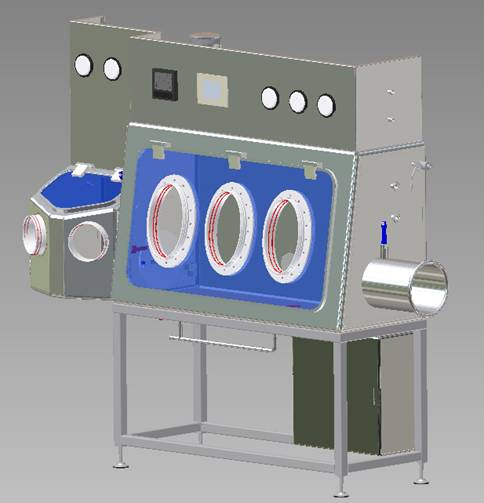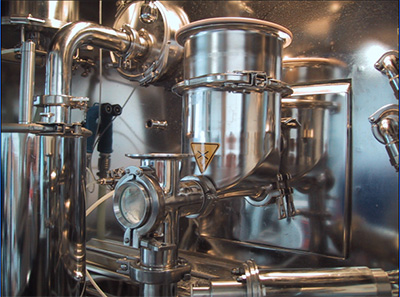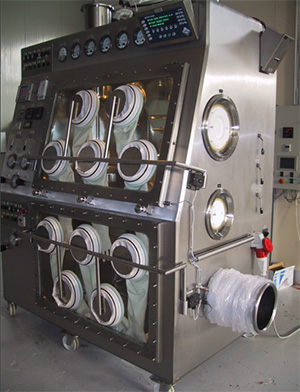FPS Food and Pharma Systems is a leading company in the pharmaceutical and fine chemical fields, developing, manufacturing and installing worldwide its own range of Fine Size Reduction machines and Containment Solutions (sterile and highly toxic API).
The higher activity and potency of new Pharmaceutical API’s, HAPI ‘s and Sterile products brings the request for tailor made containment solutions to priority level. This is required to continuously meet the safety standard and to assure the requested level of advanced technology supporting research activities and product developments. The purpose of this article is to give a wide scenario of a typical approach to develop a tailor made containment equipment to fully encounter end user requirements.
One of the main advantages of isolator technology is represented by the possibility to confine within a reasonably limited space a lot of operations that normally should be performed into separated rooms. Into a single or multi chamber isolator it is possible to perform all the operations involving product charging, sampling, processing, filling, dispensing and final discharge! With the appropriate level of automation it is also easier to control and record the environmental condition of this contained area and to monitor process parameter with no risk of external contamination. Last but not less important point is the possibility to clean or sterilize (when requested) all the process equipments inside the isolator itself, with great reduction of the cleaning operations and with simplification of the final cleaning validation phase. By the combination of these benefits, cost impact on new projects could be significantly reduced compared with standard clean-rooms containment solutions.
Approaching the preliminary discussion for a new containment system, the most important aspects to be analyzed are the boundaries definition and the process optimization in order to assure correct engineering of the system.
BOUNDARIES DEFINITION
During boundaries definition, first discussion point should be the process flow regarding material handling and material inlet and outlet flow. At this stage it is also of primary importance to define the material properties like the physical form, the hazardous properties, the method used to handle and finally the scale of the operations. By this simple preliminary evaluation it is possible to clearly define the battery limits and to establish the required level of containment for the evaluated process and operations.

Integration of capsule filling machine into FPS Isolator
It clearly appears that the containment system is not a stand alone machinery that could be installed anywhere, but it has to be engineered as integral and functional part of the overall process. Following these considerations, the importance of a full understanding of the process is clear when talking about integration into an isolator of equipments like mills, filter dryers, capsule filling machines, blistering machines, tablet presses, static ovens … each of this could have a different interaction with the isolator and the external room environment and this could compromise the whole process if not considered in the right terms.
PROCESS OPTIMISATION
Once boundaries have been clearly defined, the process should be analyzed in details and broken down into sequences in order to define most suitable containment solution. By consequence of this it is possible to propose to the end user different possible containment strategies that could be evaluated with all involved people (engineering, quality, operators, maintenance, purchasing...). Using a customer oriented approach it is always possible to find a tailor made solution that will cover all the main aspect of the process, with an important focus on the final project cost and on the environmental aspects. Part of the process optimization is the capability to integrate different process equipments and operations into one single isolator. This is going to reduce the exposure surfaces, with direct consequence of limiting occupation of space, reducing cost of operation, reducing cost of maintenance and very important nowadays reducing the environmental impact that is assuming a priority aspect into new facility design.
ENGINEERING PHASE
To help process optimization a great step forward has been done by introducing few years ago CAD 3D modeling systems. With this technology it is easier for the end user the full understanding of the final system layout. It makes also easier the evaluation of the ergonomic aspects, of the final battery limits and of the process itself. End user is asked to take active part at this phase in order to evaluate any possible improvement for final system optimization.

3D model of Laboratory equipment Isolator
At the end of this phase the system should be ready for the final manufacturing with all possible aspect already discussed and optimized. In case of very complex system layout an extra stage could be added, where a mock-up is built in order to perform final ergonomic study prior to start with final manufacturing phase.
CASE STUDY
As example of the above mentioned approach to project management activities, hereafter is described the project for the integration of a multi process system for powder milling and micronizing into an OEB 5 glove box isolator.
The project requirements were for the containment of a milling process with a Pin-Mill application a micronization step (micronization to be achievable with 2 interchangeable spiral jetmills in function of batch size). Due to final product requirements, the 2 processes should have been performed independently. The process requirements were including the option to perform both milling and micronization in cryogenic condition below to -130°C. Requirements were also including for both the process equipments full cleaning into the containment station to reduce any possible external contamination.

Detail of isolator internal integration
Product charging was requested by RTP transfer system, in order to use already available false containers with beta-flange fitting. Product discharging was to be discussed. Final requirements were for weighting operation and packaging prior to isolator discharge. Important aspect to be considered was the restricted area for containment system installation.
After boundaries definition and clarification, the process optimization phase brought to the possibility to integrate into one single glove box isolator all the previously discussed features and equipments. So the isolator has been finally engineered to be able to integrate into one single chamber:
• A multi application mechanical mill (pin-mill and hammer mill)
• A 4” spiral Jetmill (FPS PilotMill-4)
• A 2” spiral Jetmill (FPS PilotMill-2)
• A dosing unit device
• A Weighting station
The integration allowed the possibility to install the Pin-mill or the 4” Jetmill (FPS PilotMill-4) in alternative with a 2” Jetmill (FPS PilotMill-2). The feeding of the product into the process equipments was assured by the integration into the isolator of a volumetric twin screws feeder. All the system was also engineered for future possible installation of an FPS QMill-6 as alternative to the mechanical mill.
The system was foreseen for double containment when assembled and ready to operate.
Product packaging and weighting was assured by an internal weighting system completed with external control panel and printing device. Final discharging performed through DPTE transfer ports or (in function of final requirements) by an endless liner with thermo-sealing equipment. Internal CIP was performed by means of spray balls and spray gun, fed by an external dedicated CIP skid for controlled liquid supply and recirculation.
The isolator internal environment has been engineered to be able to work with cryogenic process gas without affecting interaction with external room and with operator actions.
System manufacturing was in accordance with URS and process requirements. Safety features to assure required level of containment were included:
• Safe change H14 HEPA filters (push trough type)
• Containment breach alarm to assure an inrush velocity of 0.7 m/s through an open glove port
• Separation of technical area for maintenance access
• Fail safe instruments
• RTP ports
• Endless liner
• Safety interlocks
• Restricted glove access by protection bars
Construction material for barrier isolator was AISI 316L with internal polishing lessthan 0.4µm and external polishing lessthan 0.8 µm. All process equipment product contact parts have a mirror polishing lessthan 0.25 µm.
A system management by means of a dedicated PLC was included to control and exchange main process parameters with final data record system. PLC purpose was also to assure all the operations to be executed in safety condition for the operator following FDA requirements and fully in compliance with cGMP to assure final product quality.

OEB5 Milling and Micronizing Isolator
CONCLUSIONS
In conclusion the mentioned case study showed how integrating a complex multi process system into a single high containment isolator could be possible following a full customer oriented approach.
The system integration was finally performed giving full support and assistance for all commissioning, validation and training activities to end user site. In this way, large time cutback in terms of overall project scheduling has been achieved with consequent reduction of overall project costs.